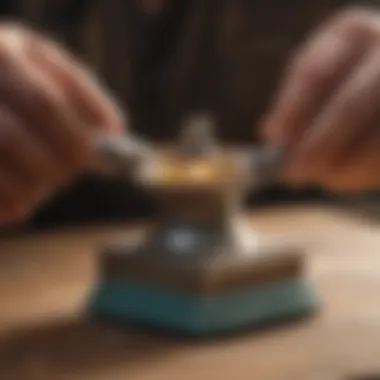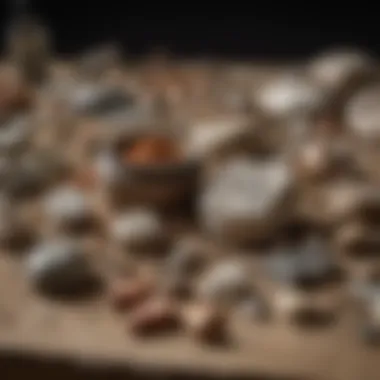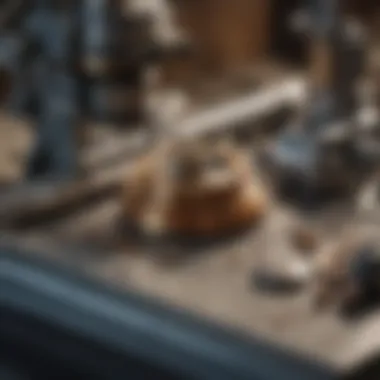Unveiling the Intricacies of Lapidary Flat Lap Grinders - An In-Depth Guide


Rock and Fossil Identification
In the world of lapidary flat lap grinding, it is crucial to have a fundamental understanding of rocks and fossils - the building blocks of this captivating hobby. Different types of rocks and fossils carry distinctive characteristics that make them unique and valuable to collectors. As enthusiasts delve into this realm, they must equip themselves with the knowledge of how to identify these specimens accurately. Utilizing specialized tools for identification, such as magnifying glasses and UV lights, can aid in uncovering the hidden beauty of each rock or fossil.
Collecting Tips and Techniques
For budding collectors venturing into the intricate world of rock and fossil collection, mastering best practices and techniques is paramount. Understanding how to identify prime collecting sites rich in geological wonders is a skill that can set enthusiasts apart. Furthermore, learning how to extract specimens safely and without causing damage is crucial to preserving the integrity of these treasures for future enjoyment.
Preservation and Display
Once collectors have amassed a collection of rocks and fossils, the next step is preservation and display. Techniques such as sealing specimens to prevent degradation and implementing proper storage methods ensure the longevity of these cherished pieces. Moreover, showcasing these treasures in creative and aesthetically pleasing ways not only adds to their visual appeal but also allows for a deeper appreciation of their natural beauty.
Geological Insights
Delving deeper into the realms of geology offers insights into the intricate processes that have shaped the world around us. Understanding geological formations and the processes involved in the creation of rocks and fossils adds a layer of depth to collectors' knowledge. Exploring the historical significance of various specimens and notable discoveries in the field provides a rich tapestry of stories that connect enthusiasts to the Earth's ancient past.
Introduction to Lapidary Flat Lap Grinders
In the expansive world of rock and fossil collecting, the role of lapidary flat lap grinders stands as pivotal. These precision tools are not simply instruments but gateways to unlocking the beauty and potential hidden within stones and fossils. As we embark on this comprehensive guide to exploring lapidary flat lap grinders, it becomes evident that understanding the basics is the foundation upon which mastery is built. Through this section, we will delve into the components of a flat lap grinder, unravel the working principles governing their operation, and illuminate the distinctive advantages they offer to enthusiasts and experts alike.
Understanding the Basics
Components of a Flat Lap Grinder
When dissecting the intricate mechanics of a flat lap grinder, one cannot overlook the essential components that orchestrate its functionality. The flat lap grinder comprises a sturdy base, a motor to drive the rotating disc, a water reservoir for cooling and lubrication, and various grit discs for grinding and polishing. Each component plays a crucial role in ensuring smooth and precise grinding operations.
The key characteristic of these components lies in their seamless integration to provide a consistent and controlled grinding experience. This cohesion results in enhanced accuracy and efficiency, making flat lap grinders a popular choice for lapidary artists. The unique feature of these components is their durability and versatility, allowing for prolonged usage without compromising performance. While the advantages of flat lap grinders are undeniable, it's essential to acknowledge the occasional maintenance they require to ensure optimal functionality.
Working Principles
At the core of every flat lap grinder lies a set of working principles that govern its operation. These principles revolve around the rotational motion of the grinding disc, supported by a constant water flow to prevent heat build-up and friction. The gradual progression from coarser to finer grit discs showcases the precision and finesse with which flat lap grinders operate.


The key characteristic of these working principles is their ability to facilitate a gradual and controlled grinding process, ensuring consistency in results. This methodical approach is a beneficial choice for individuals seeking to achieve high-quality finishes on their lapidary projects. The unique feature of these working principles is their adaptability to different types of stones and fossils, offering versatility in grinding techniques. While the advantages of flat lap grinders in terms of working principles are numerous, proper understanding and practice are essential to harness their full potential.
Advantages of Flat Lap Grinders
Unveiling the advantages of flat lap grinders sheds light on the myriad benefits they bring to the world of lapidary arts. These tools offer unparalleled precision in shaping and polishing stones and fossils, allowing for intricate designs and flawless finishes. The adjustable speed settings and interchangeable grit discs enhance the versatility of flat lap grinders, catering to various grinding needs.
The key characteristic of these advantages is their ability to streamline the grinding and polishing process, making it efficient and time-saving. This efficiency makes flat lap grinders a popular choice among lapidary enthusiasts who value both quality and productivity. The unique feature of these advantages lies in their ability to transform rough specimens into exquisite works of art, showcasing the true potential of lapidary flat lap grinders. While the advantages are abundant, it's essential to approach their usage with care and attention to detail, ensuring optimal outcomes in every project.
Techniques and Applications
In the realm of lapidary flat lap grinders, Techniques and Applications play a crucial role in enhancing the precision and quality of rock and fossil processing. These techniques are invaluable for rock and fossil collectors looking to achieve superior results in shaping, polishing, and resurfacing their specimens. The meticulous application of these techniques can elevate the aesthetic and value of the final pieces, showcasing the skill and expertise of the craftsmen involved in the lapidary process.
Grinding and Polishing
Step-by-Step Process
The Step-by-Step Process in grinding and polishing using flat lap grinders involves a meticulous sequence of actions aimed at refining the surface of the specimens. From coarse grinding to fine polishing, each step contributes to the overall clarity and smoothness of the final product. This methodical approach ensures uniformity and precision, resulting in a superior finish that is highly sought after in the lapidary community.
Tips for Achieving Optimal Results
When aiming to achieve optimal results in grinding and polishing, incorporating specific tips can significantly enhance the final outcome. Factors such as choosing the right abrasives, maintaining consistent pressure, and regular inspection of progress are essential for a flawless finish. These tips not only streamline the process but also ensure efficiency and quality in the lapidary work.
Common Mistakes to Avoid
In the lapidary world, common mistakes in grinding and polishing can hinder the overall quality of the final product. Issues such as uneven pressure, improper grit selection, and neglecting proper cleaning can lead to subpar results. By understanding and actively avoiding these mistakes, lapidary enthusiasts can elevate their craftsmanship and produce exceptional pieces that stand out in the industry.
Shaping and Resurfacing
Creating Custom Designs
Within the sphere of lapidary flat lap grinders, the ability to create custom designs is a coveted skill that showcases creativity and attention to detail. By utilizing the flat lap grinder for shaping and resurfacing, craftsmen can unleash their artistic vision and bring unique designs to life on various rock and fossil specimens. This process allows for personalized creations that resonate with collectors and admirers of lapidary art.


Repairing Damaged Specimens
When faced with damaged specimens, the art of repairing them through flat lap grinders is both challenging and rewarding. The ability to restore integrity to fractured or worn-out pieces requires precision and expertise in resurfacing. By carefully assessing the damage and implementing tailored repair techniques, lapidary artisans can salvage and revitalize valuable specimens, breathing new life into them.
Enhancing Visual Appeal
Enhancing the visual appeal of rock and fossil specimens through shaping and resurfacing is a fundamental aspect of lapidary work. By strategically polishing specific areas, emphasizing natural patterns, or adding decorative elements, craftsmen can amplify the aesthetic charm of their creations. This attention to visual detail not only enhances the overall presentation but also increases the desirability and market value of the finished pieces.
Lapidary Flat Lap Grinder Maintenance
Cleaning and Care
Proper maintenance of lapidary flat lap grinders, including regular cleaning and care, is essential for ensuring optimal performance and longevity. Removing residue, lubricating moving parts, and inspecting for wear are critical maintenance tasks that prolong the lifespan of the grinder. By dedicating time to cleaning and caring for the equipment, lapidary enthusiasts can uphold standards of excellence in their work and prevent potential breakdowns.
Troubleshooting
In the event of technical issues or performance inconsistencies with lapidary flat lap grinders, troubleshooting becomes a necessary skill for resolving problems efficiently. Identifying issues such as motor malfunctions, belt slippage, or uneven rotation requires diagnostic expertise. By troubleshooting effectively and addressing issues promptly, craftsmen can minimize downtime and maintain productivity in their lapidary operations.
Extending Lifespan
Extending the lifespan of lapidary flat lap grinders involves proactive measures to prevent wear and tear over time. Implementing regular maintenance schedules, utilizing appropriate accessories, and following manufacturer recommendations for usage can significantly extend the operational life of the equipment. By prioritizing the longevity of the grinders, lapidary enthusiasts ensure consistent performance and quality results in their lapidary endeavors.
Advanced Strategies and Innovations
In the realm of lapidary flat lap grinding, the section on 'Advanced Strategies and Innovations' stands as a pivotal aspect of this comprehensive guide. This section delves into cutting-edge approaches and novel methodologies that propel the art of lapidary flat lap grinding to new heights. By embracing advanced strategies and innovations, enthusiasts and experts can elevate their craftsmanship and achieve unparalleled precision and finesse in shaping and polishing rocks and fossils. From utilizing specialized discs and pads to incorporating automation and precision tools, this section sheds light on the progressive trends shaping the future of lapidary practices, setting the stage for enhanced efficiency and immaculate results.
Utilizing Specialized Discs and Pads
Diamond Discs
In the domain of lapidary flat lap grinding, Diamond Discs emerge as indispensable tools revered for their exceptional performance and durability. These discs, embedded with diamond particles, offer unparalleled hardness and cutting efficiency, making them a preferred choice for shaping and smoothing various gemstones and minerals. The key characteristic of Diamond Discs lies in their ability to slice through tough materials with precision, ensuring a flawless finish. Their unique feature includes the longevity of diamond grit, providing sustained cutting power over extended use. While Diamond Discs offer unmatched cutting prowess, they may tend to be on the pricier side, requiring careful handling to prevent damage to the disc surface.


Polishing Pads
Polishing Pads play a crucial role in the final stages of lapidary flat lap grinding, enhancing the luster and smoothness of polished specimens. These pads, coated with specialized polishing compounds, deliver a high-gloss finish that showcases the intrinsic beauty of gemstones and minerals. The key characteristic of Polishing Pads lies in their ability to provide a mirror-like polish with minimal surface scratches, elevating the aesthetic appeal of lapidary creations. Their unique feature includes adaptability to various materials, ensuring consistent polishing results across different specimens. While Polishing Pads excel in delivering impeccable finishes, excess pressure or incorrect usage may lead to over-polishing, necessitating attentive operation for optimal outcomes.
Resurfacing Attachments
When it comes to revitalizing worn-out flat lap grinder surfaces, Resurfacing Attachments play a vital role in restoring functionality and precision. These attachments, equipped with abrasive materials, help in smoothing rough surfaces and eliminating grinding inconsistencies, thus prolonging the lifespan of flat lap grinder discs. The key characteristic of Resurfacing Attachments lies in their capacity to refinish grinder discs effectively, ensuring uniform contact and improved grinding performance. Their unique feature includes compatibility with various flat lap grinder models, offering versatility in refurbishing different disc types. While Resurfacing Attachments excel in rejuvenating grinder surfaces, excessive use or inadequate maintenance may result in accelerated wear, necessitating proper care to maximize their resurfacing efficacy.
Automation and Precision Tools
Computerized Control Systems
In the evolving landscape of lapidary flat lap grinding, Computerized Control Systems signify a revolutionary advancement that streamlines operations and enhances precision in shaping and polishing procedures. These systems, equipped with intuitive interfaces and programmable functions, enable users to automate grinding processes with pinpoint accuracy, minimizing human errors and optimizing workflow efficiency. The key characteristic of Computerized Control Systems lies in their ability to regulate speed and pressure settings, ensuring consistent and reproducible results with minimal manual intervention. Their unique feature includes real-time monitoring capabilities, allowing operators to oversee grinding parameters and make on-the-fly adjustments for superior control. While Computerized Control Systems offer exceptional precision and efficiency, technical complexities and initial setup costs may pose challenges that require tailored training and maintenance protocols.
Digital Calibration Features
To facilitate precise calibration and measurement in lapidary flat lap grinding, Digital Calibration Features offer advanced functionalities that refine the accuracy and reliability of grinding processes. These features, comprising digital readouts and calibration tools, enable users to calibrate disc speed, pressure settings, and material removal rates with unparalleled precision, ensuring uniform finishes and consistent outcomes. The key characteristic of Digital Calibration Features lies in their ability to enhance repeatability and reproducibility, eliminating manual guesswork and variability in grinding results. Their unique feature includes user-friendly interfaces with preset profiles, streamlining setup procedures and maximizing operational efficiency. While Digital Calibration Features excel in promoting consistency and accuracy, occasional system glitches or calibration errors may necessitate troubleshooting steps and periodic calibrations for optimal performance.
Remote Operation Capabilities
In the era of remote connectivity and smart technology, Remote Operation Capabilities usher in a new dimension of convenience and control in lapidary flat lap grinding setups. These capabilities, enabled through wireless interfaces and remote control functionalities, empower users to manage and monitor grinding processes from a distance, offering flexibility and accessibility in operating flat lap grinder systems. The key characteristic of Remote Operation Capabilities lies in their ability to facilitate remote adjustments and monitoring, allowing users to optimize grinding parameters without physical proximity to the machine. Their unique feature includes compatibility with mobile devices and computing platforms, ensuring seamless integration and remote access to grinder controls. While Remote Operation Capabilities redefine operational convenience and flexibility, network connectivity issues or security concerns may warrant robust safeguards and contingency plans to uphold data integrity and operational reliability.
Industry Trends and Future Prospects
Amidst the dynamic landscape of lapidary practices, Industry Trends and Future Prospects signal the progressive evolution and transformative developments that shape the trajectory of flat lap grinder technology and applications. These trends encompass emerging technologies, sustainability initiatives, and market growth forecasts that herald a new era of innovation and sustainability in the lapidary sector, paving the way for enhanced productivity, environmental stewardship, and market expansion.
Emerging Technologies
The infusion of Emerging Technologies into the realm of lapidary flat lap grinding revolutionizes conventional practices and ushers in a wave of cutting-edge solutions that optimize performance and quality. These technologies, ranging from AI-assisted grinding algorithms to advanced material analysis techniques, offer unprecedented insights and capabilities that redefine the boundaries of lapidary craftsmanship. The key characteristic of Emerging Technologies lies in their capacity to push the boundaries of innovation, introducing novel approaches and tools that unlock new creative possibilities and efficiencies in specimen processing. Their unique feature includes adaptive learning systems that refine operational techniques and streamline workflows, propelling lapidary practices into a realm of unparalleled precision and efficiency. While Emerging Technologies promise groundbreaking advancements and efficiencies, integration challenges and technology adoption barriers may necessitate robust training and implementation strategies to harness their full potential.
Environmental Sustainability Initiatives
Driven by a growing consciousness towards environmental conservation and sustainable practices, Environmental Sustainability Initiatives play a pivotal role in reshaping the landscape of lapidary flat lap grinding towards eco-friendly and resource-efficient methodologies. These initiatives, encompassing waste reduction strategies, energy-saving measures, and eco-conscious material sourcing, advocate for responsible stewardship of natural resources and ecosystems. The key characteristic of Environmental Sustainability Initiatives lies in their commitment to reducing carbon footprint, minimizing waste generation, and promoting ethical sourcing practices within the lapidary industry. Their unique feature includes eco-certifications and compliance standards that validate sustainable practices and accountability across the supply chain. While Environmental Sustainability Initiatives uphold the principles of environmental responsibility and sustainable development, cost implications and operational adjustments may require a balanced approach to align environmental goals with economic considerations.
Market Growth Forecasts
Through in-depth analysis and market insights, Market Growth Forecasts present a strategic outlook on the trajectory and potential of lapidary flat lap grinder technologies, outlining key drivers and trends that shape industry dynamics and market demand. These forecasts leverage data-driven methodologies and industry intelligence to project growth opportunities, competitive landscapes, and emerging market segments within the lapidary sector. The key characteristic of Market Growth Forecasts lies in their predictive capacity to anticipate market trends, demand patterns, and competitive strategies that influence investment decisions and business planning in the lapidary domain. Their unique feature includes scenario modeling and trend analysis that identify growth vectors and opportunities for market expansion and product diversification. While Market Growth Forecasts offer valuable insights and strategic guidance, market volatility and external factors may introduce uncertainties that require agile strategies and adaptive business models to navigate evolving market conditions.







